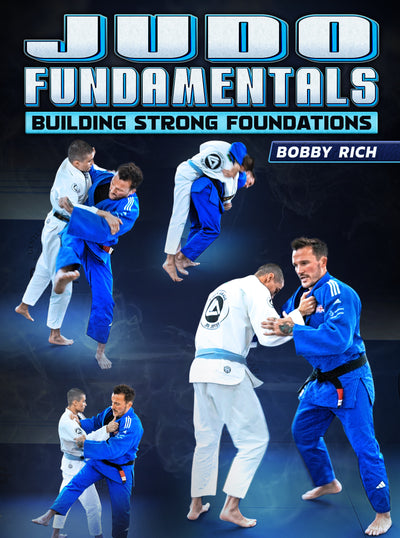The 7 Disciplines of Judo by Kizuyo Mifune
Judo is unique from Jiu-Jitsu in two ways, one of which is more important than the other.
Jiu-jitsu, or as it was called in Japan Jujutsu, was a catch-all term in Japanese that meant something like “unarmed technique”. For this reason it was also sometimes called “taijutsu”, where “tai” means “body” and “jutsu” meant technique.
The etymology of jujutsu is shared with other Japanese martial disciplines such as kenjustu, sword techniques, sojutsu, spear technique, or kyujutsu, archery techniques.
As such jujutsu was an umbrella term that contained many different schools of unarmed combat, each with its own emphasis on how to attack using the body, be that through striking, throwing or ground fighting.
The “jutsu” in Jujutsu therefore tells us the focus of Jujutsu was technical. It was the technical study of how best to use one’s own energies to defeat an opponent.
Anything outside of this consideration was not the concern of jujutsu.
In modern parlance we tend to hear of the biggest difference between Judo and Jiu-jitsu being the emphasis between standing techniques and ground techniques.
This is a conversation that has been happening throughout the history of both Jiu-jitsu and Judo, with different schools within both disciplines stressing the importance of either ground fighting or vertical fighting.
Kodokan Judo emphasised vertical grappling. Kosen Judo emphasised ground fighting. Throughout its history in Japan different Jujutsu schools emphasised a wide range of different unarmed techniques to attack an opponent.
Take your Judo to the Next Level with Ugo!
It would appear then that the technical differences are largely the most superficial, and have always been in a constant state of growth, evolution, and even change with fashionable trends.
The biggest difference between Jujutsu and the Judo pioneered by Jigoro Kano was its movement away from “jutsu” to “do”. In other words away from a consideration of technique alone, and towards a consideration of a complete way of living one’s life.
A clear example of the “do” of Judo is expounded by Kyuzo Mifune 10th Dan, who was often known as “The God of Judo”. Legend has it that in his 60 years of practice he was never thrown in competition. We will look at his 7 Disciplines of Judo below.
- Avoid Falsehood in Spirit
To bear any falsehood will give the opponent a chance to attack you, because it causes inconsistency. Technique must be decided in an instant and there is no margin for error.
- Do Not Lose Confidence
This is related to point 1. The opportunity for a technique can be lost forever in an instant. Therefore, you must act without hesitation, and with confidence.
- Correct Your Posture
The correct posture in judo is natural and flexible, and all pretentions must be avoided. The essence of life is truth; nature is forever changing because truth is omnipresent. If you are able to discover yourself within this existence you will be able to perform actions with the greatest freedom.
- Be Swift
Center of gravity follows the movement of the body, and is essential for maintaining stability. If it is lost, the body becomes unbalanced. Therefore, always fix your spirit, keep your body light, and move when needed, firmly fixing your center of gravity immediately, so as not to give the opponent any advantage.
- Use Your Power Without Restraint
Employ the use of power and swift movement together, but never assume that an all-out effort alone for one action is the end of a technique. Understand that stillness and motion, and gentleness and firmness, are the endlessly repeated processes in which truth exists. With this idea in mind you should display an infinite energy for life.
- Do Not Neglect Your Training
The method of training explained above cannot be accomplished in a short time. Techniques are to be mastered by spiritual discipline, therefore daily training should not be neglected. Everyday know that your understanding is the first step, do not lose sight of your hopes, and you will be able to follow a fresh and fulfilling existence.
- Discipline Yourself
To occupy one’s thoughts solely around oneself is to build a barrier around oneself, thereby losing one’s freedom. Truth exists beyond consciousness. Therefore if you can lose yourself in the face of an event you will be able to judge and understand the truth. Even in a match you will be able to detect your opponent’s weak points and control him easily.
The above points may appear somewhat vague, but when you appreciate these ideas you will have reached the first stage of discipline. It is also the starting point from which endless development will be possible.
It is clear by reading ‘The Canon of Judo’ by Kyuzo Mifune that Judo was not merely a collection of techniques, but a complete way of living taught through the direct practice of grappling.
The disciplines and lessons from Judo can be applied at whatever stage of life we are at, whether we are a child, a young athletic adult, or in old age.
In order to implement these lessons we need sound technical training shaped by a code of conduct, and a clear reason for all the strenuous effort we will make in a demanding sport.
It’s this level of passion that motivates us here at Judo Fanatics and why we strive to bring you the best people out there for tuition.
Whatever stage in your Judo journey we have someone that can help you go deeper and, as Mifune says, return to the “starting point from which endless development will be possible.”
 For a beautiful display of technical mastery at the highest level of competition check out ‘French Combo Throws’ by French Olympic legend Ugo LeGrand here!
For a beautiful display of technical mastery at the highest level of competition check out ‘French Combo Throws’ by French Olympic legend Ugo LeGrand here!



